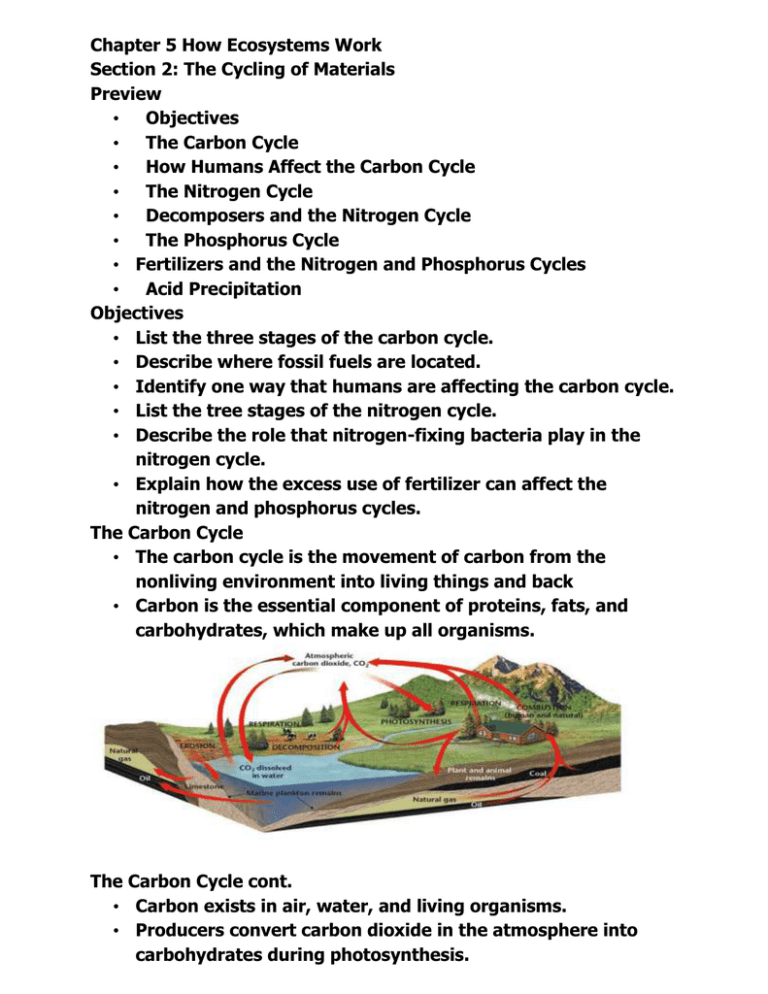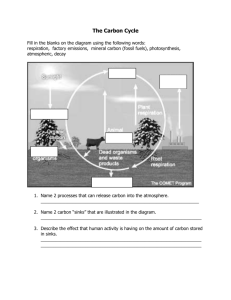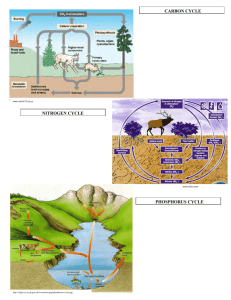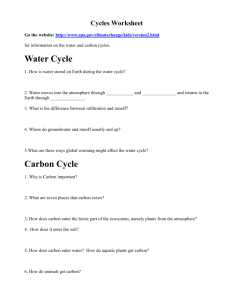Chapter 5 How Ecosystems Work Section 2: The Cycling of
advertisement

Chapter 5 How Ecosystems Work Section 2: The Cycling of Materials Preview • Objectives • The Carbon Cycle • How Humans Affect the Carbon Cycle • The Nitrogen Cycle • Decomposers and the Nitrogen Cycle • The Phosphorus Cycle • Fertilizers and the Nitrogen and Phosphorus Cycles • Acid Precipitation Objectives • List the three stages of the carbon cycle. • Describe where fossil fuels are located. • Identify one way that humans are affecting the carbon cycle. • List the tree stages of the nitrogen cycle. • Describe the role that nitrogen-fixing bacteria play in the nitrogen cycle. • Explain how the excess use of fertilizer can affect the nitrogen and phosphorus cycles. The Carbon Cycle • The carbon cycle is the movement of carbon from the nonliving environment into living things and back • Carbon is the essential component of proteins, fats, and carbohydrates, which make up all organisms. The Carbon Cycle cont. • Carbon exists in air, water, and living organisms. • Producers convert carbon dioxide in the atmosphere into carbohydrates during photosynthesis. • Consumers obtain carbon from the carbohydrates in the producers they eat. • During cellular respiration, some of the carbon is released back into the atmosphere as carbon dioxide. • Some carbon is stored in limestone, forming one of the largest “carbon sinks” on Earth. • Carbon stored in the bodies of organisms as fat, oils, or other molecules, may be released into the soil or air when the organisms dies. • These molecules may form deposits of coal, oil, or natural gas, which are known as fossil fuels. • Fossil fuels store carbon left over from bodies of organisms that dies millions of years ago. How Humans Affect the Carbon Cycle • Humans burn fossil fuels, releasing carbon into the atmosphere. • The carbon returns to the atmosphere as carbon dioxide. • Increased levels of carbon dioxide may contribute to global warming. • Global warming is an increase in the temperature of the Earth. The Nitrogen Cycle • The nitrogen cycle is the process in which nitrogen circulates among the air, soil, water, plants, and animals in an ecosystem. • All organisms need nitrogen to build proteins, which are used to build new cells. • Nitrogen makes up 78 percent of the gases in the atmosphere. • Nitrogen must be altered, or fixed, before organisms can use it. • Only a few species of bacteria can fix atmospheric nitrogen into chemical compounds that can be used by other organisms. • These bacteria are known as “nitrogen-fixing” bacteria. • Nitrogen-fixing bacteria are bacteria that convert atmospheric nitrogen into ammonia. • These bacteria live within the roots of plants called legumes, which include beans, peas, and clover. • The bacteria use sugar provided by the legumes to produce nitrogen containing compounds such as nitrates. • Excess nitrogen fixed by the bacteria is released into the soil. The Nitrogen Cycle cont. Decomposers and the Nitrogen Cycle • Nitrogen stored within the bodies of living things is returned to the nitrogen cycle once those organisms die. • Decomposers break down decaying plants and animals, as well as plant and animal wastes. • After decomposers return nitrogen to the soil, bacteria transform a small amount of the nitrogen into nitrogen gas, which then returns to the atmosphere to complete the nitrogen cycle. The Phosphorus Cycle • Phosphorus is an element that is part of many molecules that make up the cells of living organisms. • Plants get the phosphorus they need from soil and water, while animals get their phosphorus by eating plants or other animals that have eaten plants. • The phosphorus cycle is the cyclic movement of phosphorus in different chemical forms from the environment to organisms and then back to the environment. The Phosphorus Cycle cont. • Phosphorus may enter soil and water when rocks erode. Small amounts of phosphorus dissolve as phosphate, which moves into the soil. • Plants absorb phosphates in the soil through their roots. • Some phosphorus washes off the land and ends up in the ocean. • Because many phosphate salts are not soluble in water, they sink to the bottom and accumulate as sediment. Fertilizers and the Nitrogen and Phosphorus Cycles • Fertilizers, which people use to stimulate and maximize plant growth, contain both nitrogen and phosphorus. • Excessive amounts of fertilizer can enter terrestrial and aquatic ecosystems through runoff. • Excess nitrogen and phosphorus can cause rapid growth of algae. • Excess algae can deplete an aquatic ecosystem of important nutrients such as oxygen, on which fish and other aquatic organisms depend. Acid Precipitation • When fuel is burned, large amounts of nitric oxide is release into the atmosphere. • In the air, nitric oxide can combine with oxygen and water vapor to form nitric acid. • Dissolved in rain or snow, the nitric acid falls as acid precipitation.









